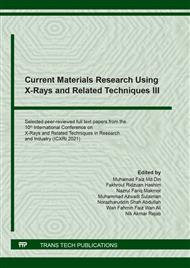p.130
p.135
p.141
p.148
p.154
p.159
p.165
p.171
p.177
Effect of Calcium Salt Coating on Cordierite Powders on Bioactivity Properties
Abstract:
Cordierite powders were synthesized via a melt-quench method. The samples were melted at 1550°C for 4 hours and immediately quenched in distilled water. The bioglass ceramic frit was milled and calcined to produce cordierite powders. After that, cordierite was treated with calcium acetate as a calcium salt in order to enhance the bioactivity of cordierite. The powders were immersed in calcium acetate solution for 24 hours and dried in the oven at 80°C for 24 hours. The mixtures were pressed into pellet form for bioactivity testing. Then, cordierite pellets were soaked in simulated body fluid (SBF) solution for 7 days. SEM micrographs show the formation of the hydroxyapatite layer on its surface after soaking in SBF solution. While EDX analysis shows the presence of calcium after the treatment. The presence of cordierite and hydroxyapatite phases were confirmed by XRD analysis.
Info:
Periodical:
Pages:
154-158
Citation:
Online since:
January 2022
Authors:
Keywords:
Price:
Сopyright:
© 2022 Trans Tech Publications Ltd. All Rights Reserved
Share:
Citation:


